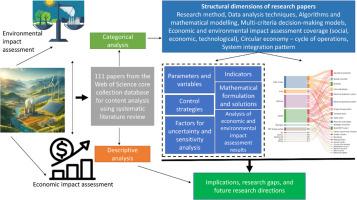Economic and environmental impact assessment of renewable energy integration: A review and future research directions
引用次数: 0
Abstract
This review article critically examines papers on renewable energy integration (REI), with a specific focus on the economic and environmental impact assessments across multiple sectors, including agriculture, transportation, electricity production, buildings, and biofuel production. A total of 111 articles from the Web of Science Core Collection database were reviewed using a systematic literature review methodology and content analysis techniques. The results indicate that evaluation-type studies, particularly those employing optimization and simulation-based methods, such as techno-economic analysis (TEA) (28 papers) and life cycle assessment (LCA) (20 papers), were the most prominent approaches used for economic and environmental analyses. Optimization techniques such as mixed-integer linear programming (6 papers), genetic algorithms (GA) (5 papers), and particle swarm optimization (PSO) (4 papers) were widely applied. The quantitative analysis of impact assessment indicators shows that REI has yielded significant long-term positive results across multiple RE sources, sectors, and regions. A detailed examination of mathematical models (e.g., optimization techniques) and simulation modeling combined with LCA will assist future researchers in optimizing energy systems and enhancing sustainability in sectors such as agriculture and water desalination. The conceptual inclusion of circular economy within the research field needs to be more present among researchers, and most of the studies focused on technical aspects of RE integration and assessing impacts rather than identifying a systemic change across the sectors. Several future research directions have been identified across sectors, offering opportunities to advance the field. Policymakers will find this paper valuable for informed decision-making and the development of robust policy frameworks.

可再生能源一体化的经济和环境影响评估:综述与未来研究方向
这篇综述文章对有关可再生能源一体化(REI)的论文进行了严格审查,重点关注农业、交通、电力生产、建筑和生物燃料生产等多个领域的经济和环境影响评估。采用系统的文献综述方法和内容分析技术,对科学网核心收藏数据库中的 111 篇文章进行了综述。结果表明,评价型研究,尤其是那些采用优化和模拟方法的研究,如技术经济分析(TEA)(28 篇论文)和生命周期评估(LCA)(20 篇论文),是经济和环境分析中最常用的方法。混合整数线性规划(6 篇论文)、遗传算法(GA)(5 篇论文)和粒子群优化(PSO)(4 篇论文)等优化技术得到了广泛应用。对影响评估指标的定量分析显示,可再生能源倡议在多个可再生能源来源、部门和地区都取得了显著的长期积极成果。对数学模型(如优化技术)和模拟建模与生命周期评估相结合的详细研究,将有助于未来的研究人员优化能源系统,提高农业和海水淡化等行业的可持续性。将循环经济概念纳入研究领域需要更多研究人员的参与,大多数研究侧重于可再生能源整合和影响评估的技术方面,而不是确定各部门的系统性变化。本文确定了几个跨领域的未来研究方向,为推动该领域的发展提供了机会。政策制定者将发现本文对于知情决策和制定强有力的政策框架很有价值。
本文章由计算机程序翻译,如有差异,请以英文原文为准。
求助全文
约1分钟内获得全文
求助全文

 求助内容:
求助内容: 应助结果提醒方式:
应助结果提醒方式:


